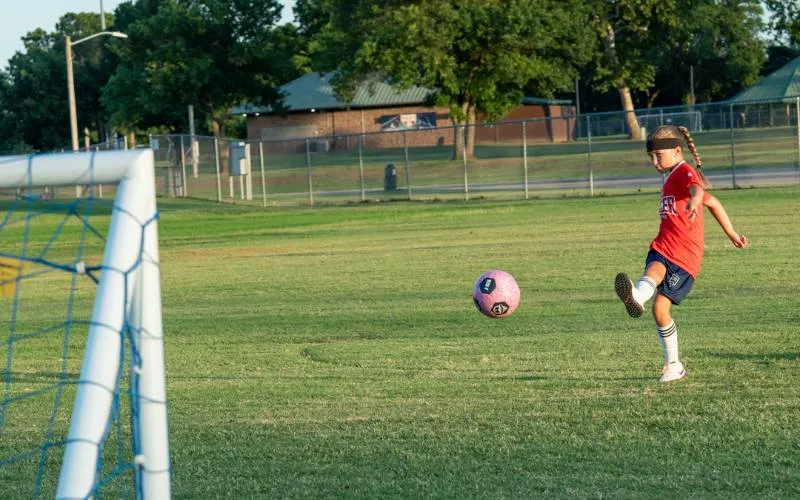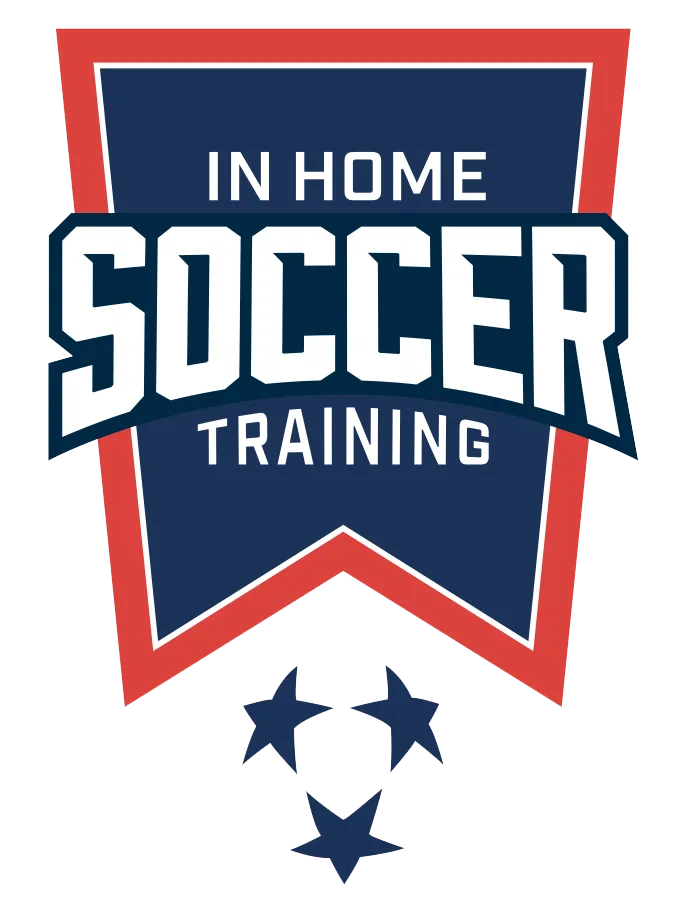Soccer shooting drills are exercises designed to help players improve their ability to strike the ball accurately, consistently, and under different game situations. They train players in body positioning, foot placement, follow-through, and shot control, while also improving decision-making under pressure.
These drills matter because accurate and controlled shooting is essential for scoring goals and performing effectively in matches. Practicing regularly allows players to develop technical skills, build confidence, and apply what they learn in training to real-game situations.
In this guide, you will learn the benefits of shooting drills and recommended practice times for different age groups. It also covers examples of beginner, intermediate, and advanced drills, plus ways to progress shooting skills for better performance.
Table of Contents
What are Soccer Shooting Drills?
A soccer shooting drill is a structured practice exercise designed to improve a player’s ability to shoot the ball accurately, with proper technique, and under various match-like conditions. In this context, “shooting” refers to the act of striking the ball toward the goal with the intention of scoring.
Shooting drills include scenarios like shooting from a stationary position, after a pass, under defensive pressure, or with time limits. According to the U.S. Youth Soccer Player Development Model, these drills are designed to improve a player’s ability to take accurate and timely shots in different game situations. This practice helps boost overall game performance.
That’s why soccer programs are built to guide players from core passing skills to advanced, game-ready soccer shooting.
What are the Benefits of Soccer Shooting Drills?
The benefits of soccer shooting drills include improved shooting accuracy, increased shot power, enhanced decision-making under pressure, improved technique and mechanics, and better match readiness.
- Improved Shooting Accuracy: Shooting drills help children develop greater accuracy by teaching them to place the ball in specific areas of the goal. Practicing with targets or marked zones allows players to control their shots and aim precisely. Over time, this focused practice translates into more consistent and effective finishing during matches.
- Increased Shot Power: Power is developed by strengthening the muscles used for striking the ball. The strength and power training are essential components that support technical execution in skills such as shooting. Research by MDPI Sports Science Journal shows that velocity-based training improves strength and ball velocity, contributing to harder, faster shots.
- Enhanced Decision-Making under Pressure: Effective shooting depends on rapid decisions about timing, angle, and technique. Training with game-like scenarios, such as time limits and defensive pressure, sharpens players’ decision-making. A review in the International Journal of Environmental Research and Public Health found that sport-specific drills improve athletes’ decision-making. Mimicking match conditions helps players react more effectively under pressure.
- Improved Technique and Mechanics: Shooting drills focus on the basics, including body position, plant foot placement, ankle lock, and follow-through. These fundamentals help improve accuracy and consistency. These details may seem small, but together they determine how accurate and controlled a shot will be.
- Better Match Readiness: Well-designed shooting drills mirror real game situations, such as striking under defensive pressure or finishing after a quick pass. This type of practice helps players transfer skills from training sessions into actual competition. By simulating the pace and intensity of a match, drills not only build technical ability but also improve confidence when shooting in high-pressure moments.
Research by National Library of Medicine – PMC on youth players aged 9–12 shows that structured practice programs improve skill performance. Focused drills are important for developing match readiness.
Level Up Shooting Skills Step by Step
Great finishers aren’t born — they’re built through repetition and smart progression. In-Home Soccer Pathways introduce kids to simple shooting mechanics, then gradually adds power, accuracy, and decision-making, so every shot feels natural and effective in game situations.
How Much Should You Practice Soccer Shooting Drill Per Day?
A focused shooting drill of 15–30 minutes a day is effective for skill development. This duration avoids fatigue when balanced with the player’s overall training and match load.
Full training sessions that include shooting drills typically last 60–90 minutes. This covers technical, tactical, physical, and recovery work in youth development programs. The U.S. Soccer’s coaching curriculum often structure sessions in that time range.
When scheduling daily practice, it is important to:
- Include rest or light days so muscles can recover and avoid injury.
- Players should monitor intensity by keeping hard shooting drills less frequent and pairing them with lighter technical work.
- Focus on quality over quantity, as shorter and well-structured sessions often lead to better improvement than long, unfocused ones.
How Much Should an Adult Practice Soccer Shooting Drill Per Day?
Adults generally benefit from 60–90 minutes of structured practice per day, about 4–5 days a week. This includes technical work (like shooting and passing), tactical drills, and physical conditioning.
About 15–30 minutes of focused practice is usually enough with other training. Rest and recovery days are essential to prevent overuse injuries and maintain performance.
Most adult players benefit from 1 to 1.5 hours of training daily, with 15–30 minutes for shooting drills.
How Much Should Youth Practice Soccer Shooting Drill Per Day?
Youth players should keep shooting-drill practice short, consistent, and age-appropriate. On average, 15–20 minutes a day of focused shooting drills is enough for younger/inexperienced children, while older youth players can extend this to 20–30 minutes. These drills should be part of a balanced training session that also includes dribbling, passing, movement, and recovery.
Children Age 7–9
For ages 7–9, shooting drills should stay short and engaging. Training sessions at this stage generally last 30–60 minutes, two to three times per week. Within that time, shooting can take about 10–15 minutes per session, usually through fun games or simple repetition drills. The focus is on enjoyment and learning correct technique, not power or tactical finishing.
Children Age 10–12
Between ages 10 and 12, players are ready for more structured shooting practice. Sessions usually run up to 60 minutes, three times per week. Shooting drills can last 15–25 minutes per session, focusing on more repetitions. They can also include different finishing types, like using both feet or shooting under light defensive pressure.
Children Age 13+
Ages 13 and above players can handle harder training loads and more realistic shooting scenarios. Sessions last 60–90 minutes, three to four times per week. Shooting drills may take 20–30 minutes per session, focusing on accuracy, power, and finishing under pressure. This stage also introduces tactical shooting situations, such as finishing after combination play or transition drills.

How a Beginner Soccer Shooting Drill Should Look Like?
A beginner shooting drill should be simple, repetitive, and focused on building correct technique. The goal is to teach players to strike the ball accurately, target their shots effectively, and build confidence in a low-pressure setting.
- Use a stationary ball at first, placed 8–10 yards from the goal.
- Encourage players to use the inside of the foot for accuracy before moving to the laces for power.
- Add cones or small targets in the goal to help with shot placement.
- Repetition is key, with 10–15 shots per player and time to reset between attempts.
How an Intermediate Soccer Shooting Drill Should Look Like?
An intermediate drill should add movement, timing, and mild defensive pressure. At this stage, players practice shooting while moving, after receiving a pass, or within a limited time to imitate real game situations.
- Begin with a teammate or coach passing the ball from different angles for a one-touch or two-touch shot.
- Add variations such as shooting after dribbling past a cone or obstacle.
- Include small-sided games (2v2 or 3v3) where the focus is on finishing quickly when in range.
- Targeted shooting (corners, low/high shots) should be practiced to build accuracy.
How an Advanced Soccer Shooting Drill Should Look Like?
An advanced shooting drill should replicate the pace and intensity of real matches. Players at this level must combine technique, decision-making, and tactical awareness under pressure.
- Introduce defenders who actively challenge the shooter, forcing quick choices.
- Combine shooting with tactical build-ups, like overlapping runs or combination play (give-and-go).
- Practice finishing from different situations: volleys, headers, rebounds, and shots outside the penalty box.
- Include short sprints before shooting to build stamina and adapt to game-time fatigue.
How Soccer Shooting Drills Help Children with Their Soccer Training
Shooting drills improve children’s soccer training by developing both technical and cognitive skills. They improve the way players strike the ball by developing proper body posture, correct foot placement, and effective follow-through. Repetition of these fundamentals allows players to execute shots accurately without consciously thinking about technique.
These drills also improve accuracy by teaching children to place the ball in specific areas of the goal rather than relying solely on power. Practicing with targets helps players develop controlled finishing, which is important for accuracy in matches.
Shooting drills contribute to decision-making as well. Drills with defenders, time limits, or angled passes help children decide quickly to shoot, pass, or dribble. This practice mirrors the fast decision-making required during actual games.
Familiarity with different types of shots reduces hesitation during matches, allowing players to attempt finishes more effectively.
Shooting drills develop match readiness by simulating real-game situations, allowing children to apply proper technique, make quick decisions, and understand tactical play.
Not Sure Which Program Fits Your Child?
If you’re unsure which pathway is right for your child’s age or experience, our Kids’ Guide makes it simple.
What Equipment Is Used for Soccer Shooting Drills?
To effectively conduct shooting drills, the following equipment is recommended:
- Soccer Balls: Standard size 4 or 5 balls, depending on the age group.
- Cones: Used to mark boundaries and set up drill stations.
- Goals: Portable or permanent goals to practice shooting accuracy.
- Pinnies: To distinguish teams during drills.
- Training Bibs: For team identification during practice sessions.

